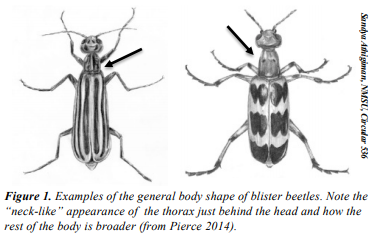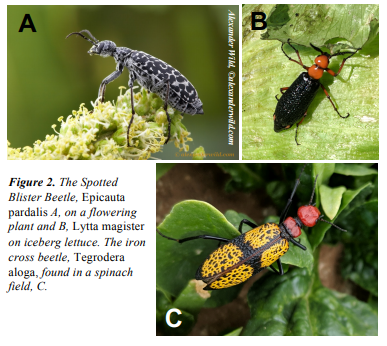Beetles in food? Yuck! Well, just eat around them! That might be an option for you, but not for livestock including horses. And perhaps not the safest option for blister beetle contamination, because these beetles produce a defensive, toxic compound called cantharidin in their blood.
This chemical is especially toxic to horses if ingested in sufficient quantity. Thankfully, the effects on humans and other animals are far less serious, but still more unpleasant than just eating a beetle!
Blister beetles (family Meloidae) are widely distributed, but only occasionally invade crop fields. Cantharidin is usually produced by male beetles and transferred to females during mating. Contact with cantharidin on the skin or mucous membranes can cause blistering or skin irritation. When ingested, the chemical irritates the gastrointestinal and urinary tracts, potentially leading to discomfort or illness, depending on the amount consumed.
While not all species of blister beetles possess the same levels of cantharidin, avoid contact with them externally and internally.
Found throughout North America, 150 species of blister beetles occur in the Southwest; the majority are never found in agricultural fields. But because of their potential for contaminating food and forage products, a grower must be familiar with the general characteristics of these beetles.
Blister beetles are recognizable by their soft body and broad head attached to a narrower thorax, creating a “neck-like” appearance (Fig. 1; Hall et al. 2019).
No antidote exists for cantharidin poisoning. Noting beetle presence in fields and preventing them from getting into harvested product is key. Blister beetles emerge in spring, but can be found during the summer months and early fall. They feed on many plants, often preferring those in flower. The Spotted Blister Beetle (Epicauta pardalis) has been found in baled alfalfa (Fig. 2a). Lytta magister was unusually abundant in 2018 and strayed from its favorite adult host, the brittlebush (Encelia spp.), to local iceberg lettuce in isolated cases (Fig. 2b). The Iron Cross Blister Beetle (Tegrodera aloga; Fig. 2c) has been found infrequently in large numbers in leafy green produce in Arizona.
Lower the Chances of Blister Beetle Contamination:
• Control weeds prior to bloom. Many blister beetles prefer flowering plants.
• Check crops before harvest. Blister beetles might congregate near field edges.
• Avoid harvesting infested portions of fields.
• Harvest / packaging practices that kill / crush blister beetles may release the toxin and can increase contamination.
•
Chemical control is never the best option; there are few effective chemicals, but more importantly, there is a risk that beetles killed in the field will be transported with harvested plants. Even after death of the beetle, cantharidin remains toxic for long periods of time. In addition, insecticides can cause beetles to release their cantharidin onto plants before they die.

